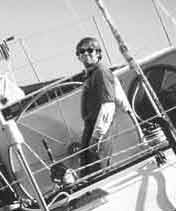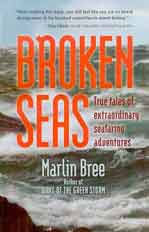
Photo courtesy of Billy Black
The Passion of Mike Plant
America’s greatest solo
sailing hero takes his final ride in
Coyote
by Marlin Bree
Copyright 2005
from Broken Seas
|
|
|
Photo courtesy of Billy Black |
 |
In a bitter storm on the North Atlantic in 1992, Minnesota racer Mike Plant disappeared under mysterious circumstances in his new racer, Coyote. In an exclusive, Northern Breezes is publishing a five-part serialization excerpted from the new book, Broken Seas. This is Serial 3 of 5 series.
Sailing to Annapolis, Coyote continued to reveal her potential. Spreading her wings on the North Atlantic, the big racer averaged 16 knots and during one stretch, she reached a sustained speed of 24 knots. Mike was elated.
But in Chesapeake Bay, Coyote ran into trouble.
Under sail at 9:30 a.m., Coyote was east of the entrance to Annapolis harbor on a reach and hitting upwards of 9 knots with a jib up and a reef in her main. “
These were perfect conditions for what Mike had in mind,” photographer Billy Black recalled. “Flat water, good wind.”
Billy was at the wheel when Coyote’s deep keel abruptly plowed into the bottom and a soft thud echoed through the hull. The big sailboat’s bow did a little dip, and she slid to a stop. “It was a soft, gentle landing,” Billy recalls. “We just settled in.”
She had run aground, burying her
14-foot deep bulb into the bottom mud
estimated at 12 to 13 feet below. In
the 12-knot wind out of the north,
Coyote started to cant sideways under
the pressure of her sails, tugging on
her keel.
According to a Coast Guard report, the following sequence of events transpired: Mike first tried to sail her off, and succeeded in heeling the big sailboat over and turning her about 180 degrees, but this maneuver did not dislodge the ballast bulb. She remained aground.
As 20-foot fishing boat passed by, Mike hailed it for help. To get more leverage to get the bulb out of the muck, they passed Coyote’s halyard to her mast top over to the powerboat. The obliging skipper gave the throttle some gas and Coyote’s mast top took up the strain. Below the water, the ballast bulb remained firmly wedged. That wasn’t working, so the boat backed up and the big sailboat came upright again.
A quick conference and it was time for another try. Mike passed a towing line aft of the bow and another line to the stern. The powerboat throttled up and slowly, Coyote’s long hull canted sideways and the buried bulb popped loose.
At the dock in Annapolis, Mike and his crew took turns looking down the sight glass at the keel. No one noticed anything abnormal.
“Mike took it in stride,” Billy said. “No problems.”
Later, as they sailed out of Annapolis, Coyote once again went aground in the bay. This time, two workboats took the big boat in tow and yanked her off the bottom.
Mike wondered whether he should take Coyote to a boat yard, hoist her out of the water and inspect for damage. The two groundings could have put shock loads and stresses on the keel and the fasteners that held on the ballast bulb.
But there was no time.
The North Atlantic – and the big race – awaited.
In New York harbor, Coyote made a triumphant debut. She looked sleek and able, a beautiful racer eager to do battle with the dark waters of the world.
With Mike at the helm, Coyote slipped along, a lithe young animal quick to respond under the reduced sail of a reefed main and a small jib. Even a little sail was enough to move the boat along smartly.
The schedule was tight, but Mike planned to sail out of New York on Friday, Oct.16, and arrive October 30 in Les Sables d’Olonne, France, 3,200 miles away. A two-week passage across the North Atlantic would be remarkably quick, but Coyote was a fast boat and Mike had been across “the Big Pond” a number of times. He knew how to drive his big boat hard, if he needed to.
Departure day was sunny but ominously breezy, with a powerful wind out of the southeast. Various well-wishers stopped by to bid Mike a swift voyage, including famed America’s Cup sailor Dennis Connors, who walked over to give Mike a copy of his latest book. “Maybe this will help you,” Dennis had joked. Mike enjoyed a good laugh: Dennis’ new book was about how to sail.
Al Roker from NBC’s Today Show interviewed Mike. Millions of viewers saw the young Minnesota sailor about to depart on his globe-girdling quest in his new racer. The TV program planned to have a satellite broadcast with Mike during the race.
Then it was time to go. Under a powerboat’s tow, Coyote gracefully moved into the harbor and past the historic windjammers at the South Street Seaport Museum. Mike gathered up fenders, cast off Coyote’s towline and raised the sails.
Free in the rising southeast wind, the big racer came to life. A cloud of canvas tightened, then grew taut as the great boat heeled and gracefully flew out of the harbor, eager for its first crossing.
Everyone stood in awe watching Mike and Coyote loping off into the distance to the awaiting North Atlantic.
“He looked straight ahead,” a spectator said. “He never looked back.”
Late in the season, the North Atlantic was changing. Always potentially dangerous, the big ocean could turn into a nightmare of gale force winds, bitter cold and broken seas as winter came on.
By his third day, the wind was blowing on the nose at 35 knots, and Mike was having trouble steering in heavy seas.
In a radio-telephone message to a friend, he called the storm, “god-awful.”
As a veteran of numerous North Atlantic crossings, he expected that he’d encounter rough conditions. But he had never anticipated the stomach-churning jolts and crashes as his new extreme racer speared waves and scooped water over the deck.
He was in the Gulf Stream, where the Labrador current becomes a virtual river of water running toward the east that should have given him an easy lift of several knots per hour toward France. But the storm was out of the east and winds were blowing against the fast-moving stream, piling it into big haystacks of waves.
Coyote would fly down the backside of one wave and partly bury her bow in the oncoming wave. Then her bow would yank up, she’d fling back a fire-hose spray and water over her deck, and, she’d climb over the wave. It was a brutal, abrupt motion, punishing to boat and man.
Mike reported that he was having trouble steering in the heavy seas and that the boat was laboring as he struggled to hold Coyote’s bow close to the wind.
Going upwind was Coyote’s worst point of sail: she was designed to be a downwind flyer. With her relatively flat bottom, razor keel and extreme light displacement, she pounded into the waves at relatively high speeds. It all added up to a bruising, miserable ride.
Coyote’s big main was deeply reefed and Mike had only a storm jib hanked on the inner forestay, but even this patch of sail seemed at times too much to offer up to the gods of the storm. Mike braced himself behind the big wheel, trying to summon up all the reserves of strength and energy he had learned to horde.
He drove her hard, for she did not point high and needed speed to cover distance. His deadline loomed.
If the North Atlantic were rough, he and Coyote would have to be rougher. He had faith they could do it.
With his phone, Mike called his friends and crew to keep them informed of his progress. He called on Friday, Oct. 16, Saturday, Oct. 17, and, 6 times on Sunday, Oct. 18. By that time, he’d slowed the boat down to about 12 knots so he could sort things out. He also was feeling optimistic and in a good mood.
But Mike made no more radio contacts until Wednesday, October 21, when he used a hand-held VHF radio to contact a passing freighter, the SKS Trader.
He was about a third of the way across the Atlantic, 940 miles from New York, and some 1,300 miles from the area where Coyote would eventually be located.
“I have no power, but I’m working on the problem,” Mike reported to the freighter’s captain, adding that he had been working on the electrical system for 3 days. He planned to have the problem solved by morning.
It turned out that on Oct. 19, he had lost not only his radios but all of his electrical power. He kept going.
Without his electrical systems, Mike had serious problems. Not only had he lost his regular radios – and could not send out an SOS, for example, if he ran into trouble, nor could he get the all-important weather reports – but he no longer had electricity to power his auto pilots. That meant he had to hand steer Coyote to keep his boat moving.
He had to watch her carefully, for she was just too slippery a racer to let fly along by herself unattended for any long periods of time. In these stormy conditions and waves, he couldn’t lash the wheel and go below to have a proper night’s sleep. He could only catnap at the wheel.
Adding to his worries was the matter of Coyote’s insurance coverage. Mike had applied for insurance for Coyote before he left New York Harbor, but he had not received confirmation that his boat was insured before he left.
Now at sea, the possibility of his boat not being covered by insurance added to his worries. If something happened to his boat, or if he lost his boat at sea, he’d be in dire financial straits.
In fact, he’d nearly be ruined financially.
In the next serialization: Two mysterious signals emanate from somewhere on the stormy North Atlantic -- and the search for Mike Plant and his missing boat begins.
Excerpted from Marlin Bree’s new book, Broken Seas: True Tales of Extraordinary Seafaring Adventure (Marlor Press, 2005). Visit his web site at www.marlinbree.com.
Continue The Vision
The Mike Plant Memorial Fund was established to provide a sailing experience for
inner city kids. Donations can be made to:
Mike Plant Memorial Fund
in care of the Wayzata Sailing Foundation
P.O. Box 768
Wayzata, MN 55391
Visit www.wayzatasailing.org/mikeplant for more information.